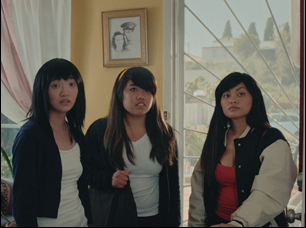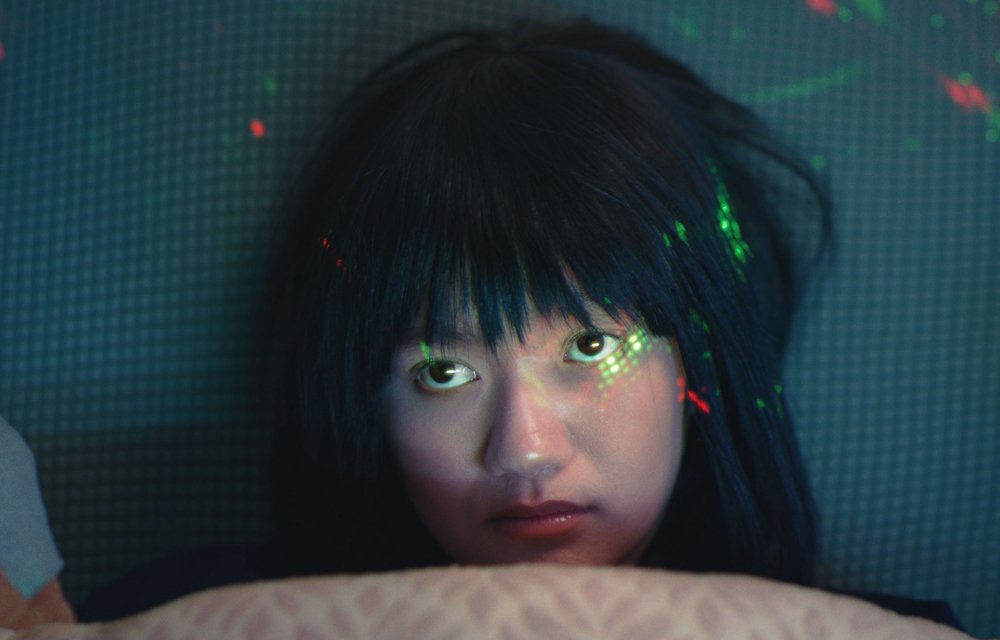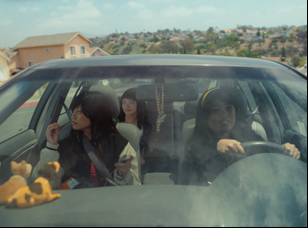Thanksgiving brings the promise of trays full of lumpia and sisig for Ly (Kailyn Dulay) in “When You Left Me On That Boulevard,” but it’s her anxieties that are piled high. Decidedly introverted, especially relative to her gregarious extended family in San Diego, she doesn’t have much to say to others and if she did, she’d worry about raising her voice loud enough to have it heard above the cacophony coming out of every room in her auntie’s house. Still, there’s a comfort there that no other place can provide, particularly when Ly’s a little woozy from the joint her cousins Jaime (Whitney Agustin) and Crizzy (Gina May Gimongala) smoke in the car before turkey can be served and additional nerves set in about a boyfriend who isn’t returning her calls.
Kayla Abuda Galang’s delightful short captures the melancholy of having left a place with an eye to the future, only to find it hasn’t left you and when Ly may be intimidated by having to ever talk about herself in front of her family or worse, having to sing when the karaoke machine comes out late in the evening, the warm familiarity of such a gathering proves as intoxicating as any other drugs available to her. Filled with minute attention to detail, “When You Left Me on That Boulevard” may specifically evoke coming of age in a Southern Californian Filipino community in 2006, but it stirs feelings of nostalgia from a cherished area no matter what road you’ve traveled and as the film finds its way into Park City this week for its premiere at the Sundance Film Festival, Galang, who previously made a splash on the festival circuit with her charming “Learning Tagalong with Kayla” that took home a top prize at SXSW in 2021, spoke about bringing her own family and audiences together with her latest crowdpleaser, the intricate work that went into the film’s immersive sound design and the story behind the song that the film takes its title from.
It’s been such a journey, but I started to think about these characters and this world roughly in like 2019 when I started to write my first feature. I let that marinate because of the pandemic, but I was just really interested in revisiting my childhood home, this very nostalgic, formative place that I left at the peak of my adolescence around 15 years old, and it’s funny because it originally felt like a pullout scene or more like a proof of concept until I think my feelings around proof of concept shorts changed. In the feature itself, [this story] was about two pages, but I stretched it out to 13 to get a sense of a family and a girl’s place in her family because I was really gravitating towards the textures and the liveliness of that space. I just feel like holiday celebrations, especially within my family and my friends’ families, those have always been really interesting and full of generational divides.
How did you find Kailyn to play the lead in this?
Kailyn actually found us. I was really interested in finding someone familiar with the area, if not from the area, because before I started making this, I wasn’t really steeped in the creative community of Paradise Hills in southeast San Diego, so I thought it would be a long shot [to find someone that fit the part]. We posted on Backstage, but also a lot of community groups on Facebook and made calls on Instagram and that’s where she found us. She submitted the loveliest self tape and I got to see her get lost talking about what she liked – she talked a lot about Paramore and how much she loved their music and how much music means to her, and I just got a sense of the bridge that I could find between her and her character, so it was a joy to find her out the blue.
Were there any ways this took on a life of its own that you could get excited about?
It’s funny because I always endeavored to make something with the community and informed by community needs and [how] they were wanting to see themselves, but I didn’t really expect it to be as magical and romantic as it turned out to be. I got to reunite with a lot of old friends and classmates, and I got to meet new generations of kids living in Paradise Hills through Kailyn and Gina. Whitney’s not from Paradise Hills – she’s from SoCal, but getting to see how they brought their own experiences to it [was special]. I also love the way that theybdisagreed with me and pointed out things that didn’t feel true to them in the world that they were inhabiting, so it was really nice to have this very safe and creative space where everyone was super-invested in taking care of the world that I was building and really generating so much more off of it. That was a big surprise.
It really looks like you got the support of the community since that house party is full – how did you pull it off?
A lot of the people in the house felt like my family, but they were actually really tied to my producer and childhood friend David Oconer, so it was a really special gift to get to work with him on this. He got to connect with a lot of his family and family friends, and I got to shoot my auntie’s house, so already this space was so familiar to [the extras] in terms of how to move about it, how to behave in it, and I felt it’s funny to see how the moms and dads and the children and the teenagers [would] just naturally divide themselves as I would naturally see at a party. But it was lots of family members and favors called.

That was such a big pillar of the filmmaking of this. We started collecting sounds and building soundscapes as early as July 2021 because we originally started [with] a proof of concept for the short to get some grants and funding and we started to go to my Lola’s church luncheons and her house parties. Then I got the opportunity to go to San Diego a few times for pre-production and we started to build off of that and even picked up more sounds after production. Even though we had a full house, there were just things that I was identifying that I wanted to go back to San Diego specifically for, so I worked alongside my partner Will Kersner who’s an excellent [sound designer], and again, I love how generative my crew was expanding on my original ideas and intent. He was always interested in finding the right chinelas hitting floor tiles or the right outside ambience because it’s not very chirpy outside of my auntie’s window [as it is in the film]. It’s very crisp and fresh and you can hear cars in the distance, so a lot of intentionality went into the sound design and building the soundscape.
Since the film takes its title from the song that’s in the film, was it of special significance from the start?
It’s actually from a pretty core recent memory of mine where I reunited with a lot of my aunties in 2019 when I visited my mom’s province. I realized that the last time I’d all seen them was roughly in 2006, and it was a weird alchemy of a familiar scene, [with] me now being an adult and having this perspective on all these nuances I took for granted. In the moment, one of my aunties just slowed things down with “Boulevard“ by Dan Byrd and I immediately clocked it immediately – and uncharitably – as a very memorable power ballad, but it had a slowness and dramatic longing that I just really gravitated towards and I think it actually even created the lens through which I made the film. I can’t really speak to the specifics of the lyrics [influencing it], but I think it does speak to a feeling of longing, whether it’s for a certain time or place or for the people in the film.
What’s it like to have this film at Sundance?
I’m still actively processing it. I’m very sleep deprived right now and I took a break from the movie right after I submitted to Sundance – I submitted literally the hour before the late deadline came up and I took a big break [from it] because that was just a big, like “We got there, we got to the application, we’re done for now.” Then when I got the call, I was like, “Oh crap, I actually need to finish this now.” So it was a pretty mad dash from mid-November to or through December and just getting here and I’m just trying to stay curious and open. It’s my first, big festival circuit [run] that’s not online, so it’s been very surreal and very dizzying, but very exciting.
“When You Left Me on That Boulevard” will screen at the Sundance Film Festival as part of Short Film Program 3 on January 23rd at 12:30 pm at the Redstone Cinemas in Park City, January 24th at 12:45 pm at the Broadway Centre Cinemas in Salt Lake City, and January 28th at the Megaplex Theatres at the Gateway at 7:30 pm at Salt Lake City. It will also be available virtually from January 24th through 29th.





